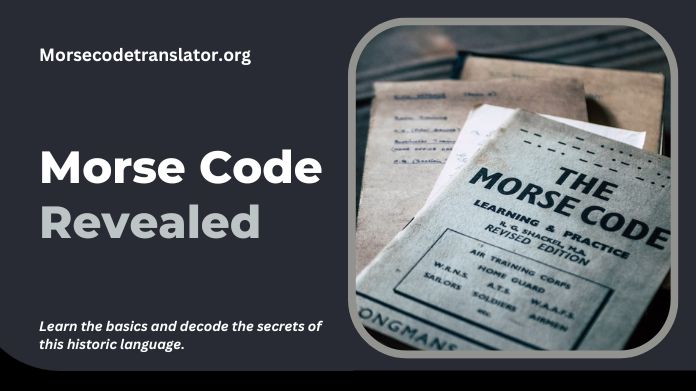A dependable and effective type of communication that has withstood the test of time is Morse code revealed, which is a sequence of on-off tones, clicks, or lights used to send written information.
The Morse code, created in the early 1800s by Samuel Morse and Alfred Vail, transformed long-distance communication and was the foundation of telegraphy for many years. Morse code is still used in various industries, including amateur radio operations, aviation, and maritime communication, despite technological advances.
In this comprehensive guide, we delve into Morse code basic, history, structure, and practical applications. From its humble beginnings as a simple system of dots and dashes to its widespread adoption as a universal communication standard, Morse code revealed fascinates and intrigues enthusiasts worldwide.
Whether you’re a seasoned Morse code operator or a curious novice, this article aims to demystify the intricacies of this timeless communication method, providing insights into its significance and practical uses in the modern era.
Join us on a journey through the world of Morse code revealed as we unravel its secrets and uncover the enduring legacy of this iconic communication system.
What is Morse Code?
Morse code transmits text information using a series of on-off tones, clicks, or lights. It utilizes combinations of dots and dashes, known as “dits” and “dahs,” to represent letters, numbers, and punctuation marks.
Developed in the early 19th century by Samuel Morse and Alfred Vail, Morse code revolutionized long-distance communication, mainly through telegraphy. Each character in the English alphabet, as well as numerals and standard symbols, is assigned a unique sequence of dots and dashes.
Morse code can be transmitted audibly through sound, visually through lights or flags, or through tactile means like vibration or touch. Despite technological advancements, Morse code remains relevant in various fields, such as aviation, maritime communication, and amateur radio operations.
Its simplicity, efficiency, and reliability have contributed to its enduring popularity and continued use in modern communication systems.
Morse Code Revealed: Basics of Morse Code

Here are some basics of Morse code:
1. History: Morse code was developed by Samuel Morse and Alfred Vail in the early 19th century. It revolutionized long-distance communication, mainly through telegraphy.
2. Alphabet: In Morse code, each alphabet letter is represented by a unique combination of dots (short signals) and dashes (long signals). For example, the letter “A” is denoted by “-” and “B” by “-…”.
3. Numbers and Punctuation: In addition to letters, Morse code also includes representations for numbers and standard punctuation marks.
4. Transmission: Morse code can be transmitted audibly through sound, visually through lights or flags, or through tactile means like vibration or touch.
5. Applications: Morse code has been widely used in various fields, such as aviation, maritime communication, and amateur radio operations.
5. International Morse Code: While the English Morse code is the most widely known, there are variations for other languages and international communication.
Understanding these basics is essential for effectively decoding and transmitting messages using Morse code.
Application of Morse Code Revealed
The application of Morse code spans various fields and industries. Here are some key areas where Morse code is still utilized:
1. Aviation and Maritime Communication: Morse code is used in aviation and maritime communication, particularly when radio communication is limited or unreliable. Pilots and sailors may use Morse code to transmit distress signals, navigation instructions, or other critical messages.
2. Amateur Radio Operations: Morse code remains a popular mode of communication among amateur radio enthusiasts. Many amateur radio operators, or “ham radio operators,” continue to use Morse code as a reliable and efficient means of communication, particularly in long-distance or low-bandwidth scenarios.
3. Emergency Situations: Morse code revealed is sometimes used when traditional communication methods are unavailable or compromised. Emergency responders, search and recovery teams, and disaster relief organizations may use Morse code to coordinate rescue efforts or convey critical information.
4. Military and Defense: While its use has declined with technological advancements, Morse code still plays a role in military and defense communications, particularly in encrypted or covert communications where security is paramount.
5. Historical Preservation: Morse code is also used for preservation purposes, particularly in museums, historical sites, and educational institutions. Learning and understanding Morse code helps preserve its legacy and significance in the history of communication.
While its use may have diminished in some areas due to technological advancements, Morse code remains a valuable and versatile communication tool in various niche applications where reliability, simplicity, and efficiency are paramount.
Conclusion
Morse code revealed remains a timeless communication method cherished for its simplicity and reliability. From its inception in the 19th century to its continued use today in aviation, maritime, and amateur radio operations, Morse code has proven its enduring significance.
Its basics, including its alphabet, transmission methods, and applications, illuminate its versatility and impact on communication. Reflecting on Morse code’s legacy, we recognize its enduring value in our technological landscape and its role in shaping how we connect and communicate.
Thanks for reading!!
